Growing Green Beans Or Runner Beans For Big Harvests is Easy to Learn
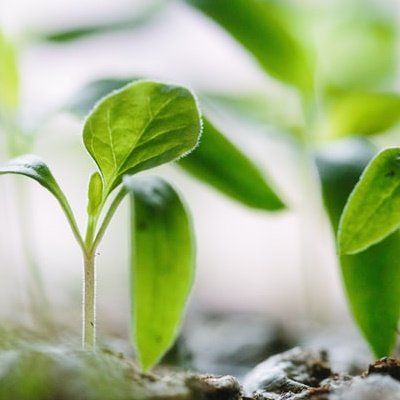
By growing Green Beans or Runner Beans as they are also called, you will have an abundance of fresh nutritious vegetables. They arrived from South America not long after the French Bean and were initially grown for their looks - what a waste. We now enjoy growing Green Beans for looks AND healthy eating.
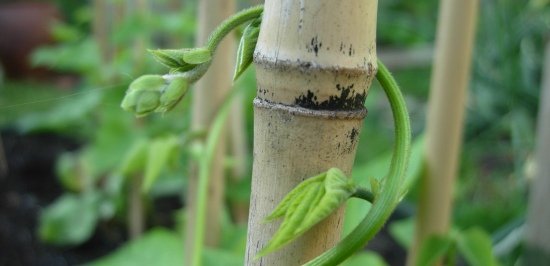
It is in Britain they are called Runner Beans and in the USA - Pole or
Green Beans. But in Britain they are one of our favourite home grown
beans and can be seen in summer growing up cane wigwams or clambering
through netting or indeed any structure that allows this delicious
vegetable to entwine itself. When growing Green Beans a 3.6M row can
produce upwards of 27Kg of beans from August to the first frosts of
winter - WOW!
Remember - growing Green Beans of this type is easy to learn but don't treat it as an easy plant to grow. The ground will need to be prepared in winter, regular watering in summer... especially in dry weather and when the pods are forming. During harvesting in late summer - do not - let any pods reach maturity as this will stop the flowers from forming. So picking very regularly is essential for continual vegetable production - be a good neighbour and give some away.
Growing Green Beans - Soil Details
Runner Beans must have a rich and deeply dug soil (pH6.5-7.0) in a shelterd part of the garden, lime if necessary in late winter as acid conditions are undesirable.
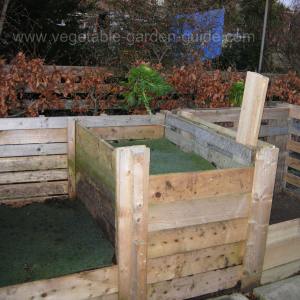
Foliage is dense and so wind damage could occur if too exposed - also ensure that the shade cast by these plants will not be a problem to other growing vegetables.
Green beans will tolerate some shade but full sun is preferred.
If you're growing Green Beans like Pole or Runner Beans in a row, dig a trench during the autumn or winter 45(18")cm wide to a spade's depth.
Dig plenty of well rotted compost or manure into the soil in the bottom of the trench - this will ensure the vegetable plants will get all the nutrients and trace elements they need as well as helping to retain moisture around the roots.
If your growing your Pole or Runner Beans up a wigwam frame dig the compost or manure into a large circle of ground over which your wigwam will be erected.
If you have the space, don't forget to make room near your vegetable growing plot for a composting area. Once you have made your own compost for a first time you will be hooked - it's an amazing process... truly truly amazing!... and your green beans will love it.
Two weeks before sowing or planting rake in a general fertilizer.
Planting Out Your Green Beans
Pole or Runner Beans are easily damaged by frosts. To minimise this when growing Green Beans sow their seeds indoors in a light airy place or in your greenhouse. Sow the seeds into pots (two beans per pot) in April. Thin the plants leaving the strongest to to be planted out. If you like, leave them both in the pot and plant out together as one root ball - they will grow and give you a great crop. Harden off for planting out in late May or June - or earlier if you know your weather.
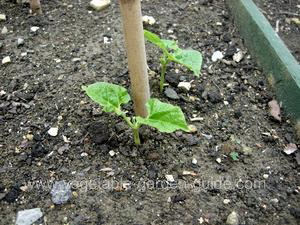
The usual method of growing green beans is to sow them outdoors when all danger of frosts is past:
- End of May in the South of Britain
- During June in the North of Britain
First erect a structure of poles(bamboo canes - I use 2.4M(8ft) canes) for your green bean plants to grow up. Form a double row of poles 45cm(18") wide along the length of your prepared bed and push the poles into the ground 25cm(10") apart.
Draw each opposite pair of poles together and tie them about 15cm(6") from the top or use a universal cane support. Insert a pole horizontally in the V shapes that are made by doing this and tie this pole in, this creates a stabalising ridge pole. If you grow more than one double row leave 1.5M(5ft) between double rows.
Use a wigwam frame if space is short. Place a single pole at the centre then measure 40cm(15") out from the pole in the north, south, west and east directions and push a pole into the ground at each point.
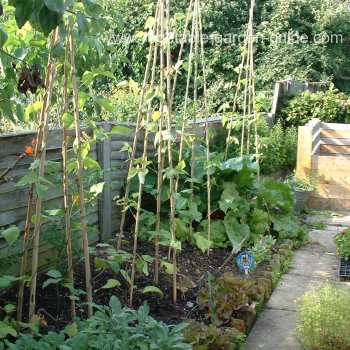
Then measure again from the central pole 40cm(15") to each point in between the four you have just done - pushing a pole into the ground at each point.
Draw all the poles at the top to the centre around the central pole and tie them together about 15cm(6") from the top - a large cable tie from you DIY store is good for this. This will give you 9 poles to grow your Runner Beans up - enough for a sizeable harvest.
Make a hole at the base of each pole 5cm(2") deep and pop in a couple of seeds, then cover the seed with soil. If both seeds germinate then thin out the smallest or just leave them to grow. Sow a few extra seeds at the ends of each row to use as transplants for any that fail to germinate along your rows.
When growing Green Beans, a second sowing in June in mild areas will give a welcome crop in October.
To further ensure your success at growing Green Beans, purchase seedling plants from your nursery or garden centre. When all signs of frost has passed plant them out along your rows of poles or around your wigwam structure. This method is strongly recommended if you live in cold areas.
Water your seeds or seedlings on completion.
Growing Green Beans - Caring For Your Plants
If you did the ground work by preparing the soil properly prior to planting your Green Beans then there is little else to do except:
- Gently tie the young shoots to the poles they will then begin to climb
- Hoe to keep the weeds down
- Mulch around the plants to give extra feed and conserve moisture - this will also keep weeds at bay
- Remove the growing tips once the plants have grown to the top of the support poles
- Keep them well watered when the pods begin to form
At the end of the growing season dig in the roots of your Runner Beans as they will make excellent nitrogen fertiliser. The roots have the capability to extract nitrogen from the air and store or 'fix' it in small nodules on their roots. So don't feed your Green Beans excessively with nitrogen fertilisers.
| Expected germination time | |
| Life expectancy of stored seed | |
| Approx. time between sowing and harvesting | |
| Cultivation facts |
Pest Control
Black Bean Aphids adore Green Beans - keep a dilligent watch for their appearance. A serious infestation will badly stunt plant growth. Check over the leaves and stems of your Runner Beans, especially the tender growing tips... gently squish any colonies you find - gently for the sake of plant not the aphids ;0).
If you are watering your growing green Beans with a hose, try knocking the aphids off with the spray - this can be quite effective. Also, try growing flowers like Tagetes or Marigolds in between rows to attract beneficial insects like hoverflies and lady birds which love to eat blackfly
A chemical spray may be required if the infestation becomes too serious. Pop into your local garden centre or nursery and ask their advice what to use.
Slugs can also be a problem and can be dealt with using a combination of different methods:
- Go into your vegetable garden at night with a torch and collect the slugs by hand - they can be disposed of by placing in a box containing salt.
- Place barriers around the plants... something rough that makes it difficult for them to slither on - like egg shells or sand. Or cover your seedlings with plastic bottles with both ends cut off and pressed into the soil over them.
- Nematodes are a very effective way to kill slugs without harming people or wildlife and is becoming a popular method of control. Nematodes are naturally occuring organisms which can't be seen by the human eye.
Sold in packets - purchase them at garden centre or nursery, place the the contents as directed into a watering can, add water then apply to your vegetable garden. These little darlings then enter the slugs and kill them. They go on being effective in the soil for about six weeks.
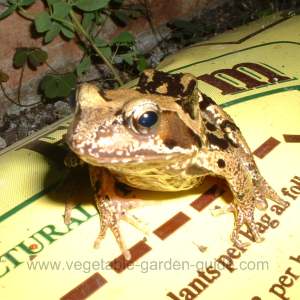
- Slug pellets are effective but need to be used sparingly as they can be a danger to wildlife because the chemicals metaldehyde or methiocarb they contain.
- I live next to a small stream so I am blessed with lots of frogs in my vegetable beds - they love slugs - I disturbed this little fella whilst I was watering my peppers in the greenhouse.
- Encourage beneficial wildlife around your veg patch - for example, purchase a purpose built hedgehog home. This all increases the enjoyment of your vegetable growing experience.
Halo Blight is a disease that there is no cure for. Small brown spots appear on the leaves and each one is surrounded by a yellow 'halo'. Unfortunately this causes your growing Green Beans to produce fewer pods and the plants themselves become stunted.
To minimise blight problems don't soak seeds before planting - the blight is in the seed. Use only seed purchased from a reputable source - your friend might have meant well when sharing his saved seed from last year - I personally would not take the chance.
Dig up infected Runner Beans and destroy.
A complaint I hear often and indeed have experienced when growing green beans is the poor setting of the flowers. Three main reasons that I have discovered are:
- Lack of moisture at the roots ie. poor watering regime.
- Poor weather conditions causing a decline in insect life which affects fertilization. I grow Moonlight Green Beans which are self polinating and white flowered - which seem less desirable to birds.
- The debudding of the flower spikes caused by birde who love to eat those young tender flower buds.
For two of the above problems you can be pro active. If you see birds getting at your growing green beans then protect them with a netting barrier. As far as watering is concerned, make sure you give them plenty. But I'm afraid the bad weather and low count of insect life just has to be lived with :0( .
Harvesting
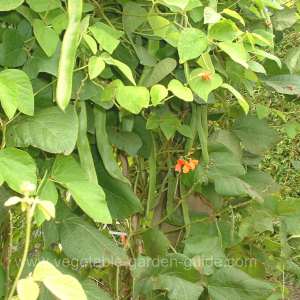
Harvesting can begin in July but the main months are August to October. Aim to harvest your growing Green Beans when they are young, tender and succulent - not to show off some monster that have strings in them like old rope.
Pick regularly once the pods have reached a decent length of 15-20cm(6-8") but ensure they are picked before the beans inside begin to swell. By doing this - it may mean picking every day or two - the harvest period can go on for 6-8 weeks. Production will stop if you allow even a few to ripen.
If you have a glut of green beans then freeze some, give some away or compost them - I know... it does'nt bear thinking about - but the point is... don't stop picking.
They will also stay fresh in the refrigerator if sealed in a plastic bag for up to a week, or in an open container in the kitchen for 3-4 days.
So there you have it - if done properly growing Green Beans like Runner Beans will reward you with a fantastic harvest from a small space planted up with just five or six plants. Do give them a go... you won't be disappointed.





